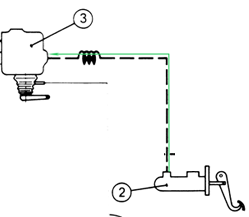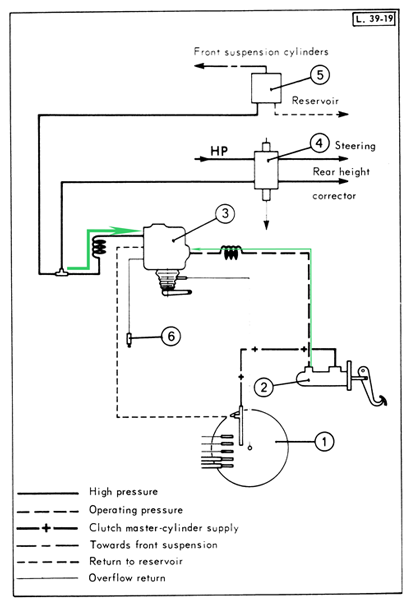|
The 2200 came from the factory with a cable-operated clutch whose
effort is positively agricultural. Very heavy, particularly in
comparison with the light effort needed to operate the brakes and
steering. From 1979(?) to July 1983 Citroen used a hydraulic
clutch on the Prestige. Being Citroen, it would not suffice to
use just a master-slave system like every other manufacturer on the
planet. True to the original design principles of the DS,
the effort to operate the clutch comes not from the driver, but from
the engine. The driver's actuation of the clutch is more a
regulation of the HP pressure acting on the slave cylinder, similar to
the brake doseur. |
|
There are two
main components to the system, a master cylinder and the slave
cylinder. The design of the master cylinder is similar to the
master cylinders you'd find on most other cars. There is a small
piston that moves inside the cylinder, and at one end of the cylinder
is a hydraulic connection for a 4 1/2 millimeter pipe. This pipe
is routed down to the bottom of the transmission, where it is
connected to the slave cylinder. On conventional cars, the
slave cylinder is just a larger version of a master cylinder, just
operating in reverse. There is a piston that is displaced by
hydraulic pressure. The piston presses on a lever that actuates
the clutch. The driver creates hydraulic pressure in the master
cylinder by pressing on the clutch pedal, this pressure causes the
piston in the slave cylinder to move, and this movement releases the
clutch. Here's a diagram that depicts the components of a
conventional hydraulic clutch. |
 |
#2 is the master cylinder, #3 is the slave
cylinder. |
| The Citroen CX slave cylinder
is radically different from the conventional slave cylinders fitted to
other cars. In most cars, the pressure from the master cylinder
moves the slave cylinder directly. In the Citroen arrangement,
pressure from the master cylinder acts upon a small slide valve.
When this small slide valve moves, it opens up a connection that
delivers high pressure to the actual slave cylinder itself. So,
in the Citroen system, pressure on the clutch pedal does not directly
act upon the slave cylinder. Rather, it simply opens a small
valve, enabling the slave cylinder to be moved by high pressure
created by the engine. The amount of force necessary to move the
small slide valve is a fraction of the amount of force necessary to
move the slave cylinder. |
|
|
| Here's a diagram from a
Citroen shop manual that presents the system. I added a thin green
line to show pressure from the clutch pedal, and the heavier line to
show HP |
|
 |
- Hydraulic Reservoir
- Master Cylinder
- Slave Cylinder Mechanism
- Priority Valve, (Ensures steering has enough
pressure before delivering pressure to front suspension/ clutch &
rear suspension)
- Front Height Corrector
- Bleeder valve
|
I've divided the pages covering the clutch into components:
|